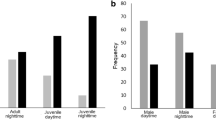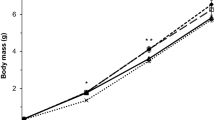Abstract
Armoured animals generally exhibit two main antipredator responses: They either flee or stay motionless, withdrawn in their protective armour. The transition between these two threat reactions can be affected by the degree of armour sturdiness. Tortoise shell stiffness gradually increases through ontogeny due to ossification. Additionally, neonates do not benefit from parental protection. Thus, juvenile survival could rely strongly on behavioural adaptations. This experimental approach addresses the effects of age (size), morphology, sex and population of origin on the transition between the two strategies. Predator attack was simulated by overturning individuals on their backs. Juveniles displayed bolder threat response comparing to adults. They also spent shorter periods of time withdrawn in shells and inspecting surroundings. Immature tortoises from all localities had high self-righting success, contrary to adults. The deterioration of righting success coincides with age of sexual maturation. Prompt switch from hiding to fleeing strategy in threatened juvenile tortoises implies that natural selection acts strongly on their swiftness and agility. Sexes did not diverge in antipredator displays. Self-righting speed correlated with shell shape in both juveniles and adults. Morphological measurements used in this study affected self-righting speed only in adults. These effects were accompanied with a general negative effect of increase in body size. Further studies should explore how frequency of predator encounters (i.e. experience) shape antipredator behaviour of tortoises. This could have conservation implications, especially for efficient releasing of animals from captive breeding programs.



Similar content being viewed by others
References
Andrews RM (1982) Patterns of growth in reptiles. In: Gans C, Pough FH (eds) Biology of the reptilia. Academic Press, London, pp 273–320
Armstrong DP, Brooks RJ (2014) Estimating ages of turtles from growth data. Chelonian Conserv Biol 13(1):9–15
Barje F, Slimani T, El Mouden EH, Lagarde F, Bonnet X, Ben Kaddour K (2005) Shrewd shrikes and spiny shrubs: a calamity for hatchling Moorish tortoises (Testudo graeca graeca). Amphibia-Reptilia 26:113–115
Bjurlin CD, Bissonette JA (2004) Survival during early life stages of the desert tortoise (Gopherus agassizii) in the south-central Mojave Desert. J Herpetol 38:527–535
Bonnet X, Lagarde F, Henen BT, Corbini J, Nagy KA, Naulleau G, Balhoul K, Chastel O, Legrand A, Cambag R (2001) Sexual dimorphism in steppe tortoises (Testudo horsfieldii): influence of the environment and sexual selection on body shape and mobility. Biol J Linn Soc 72:357–372
Cailleux A (1947) L'indice d'emousse: definition et premiere application. Comptes rendus sommaires des Seances. Soc Geol de France 13:250–252
Caro T, Shaffer HB (2010) Chelonian antipredator strategies: preliminary and comparative data from Tanzanian Pelusios. Chelonian Conserv Biol 9:302–305
Carrier DR (1996) Ontogenetic limits on locomotor performance. Physiol Zool 69:467–488
Cebra-Thomas J, Tan F, Sistla S, Estes E, Bender G, Kim C, Riccio P, Gilbert SF (2005) How the turtle forms its shell: a paracrine hypothesis of carapace formation. J Exp Zool Part B 304:558–569
Civantos E, Forsman A (2000) Determinants of survival in juvenile Psammodromus algirus lizards. Oecologia 124:64–72
Creer DA (2005) Correlations between ontogenetic change in color pattern and antipredator behavior in the racer, Coluber constrictor. Ethology 111:287–300
Delmas V, Baudry E, Girondot M, Prevot-Julliard AC (2007) The righting response as a fitness index in freshwater turtles. Biol J Linn Soc 91:99–109
Djordjević S, Djurakić M, Golubović A, Ajtić R, Tomović L, Bonnet X (2011) Sexual body size and body shape dimorphism of Testudo hermanni in central and eastern Serbia. Amphibia-Reptilia 32:445–458
Fritz U, Auer M, Bertolero A, Cheylan M, Fattizzo T, Hundsdörfer AK, Martín Sampayo M, Pretus JL, Široký P, Wink M (2006) A rangewide phylogeography of Hermann’s tortoise, Testudo hermanni (Reptilia: Testudines: Testudinidae): implications for taxonomy. Zool Scr 35:531–543
Germano DJ (1988) Age and growth histories of desert tortoises using scute annuli. Copeia 1988(4):914–920
Germano DJ, Bury RB (1998) Age determination in turtles: evidence of annual deposition of scute rings. Chelonian Conserv Biol 3:123–132
Golubović A, Arsovski D, Ajtić R, Tomović L, Bonnet X (2013a) Moving in the real world: tortoises take the plunge to cross steep steps. Biol J Linn Soc 108:719–726
Golubović A, Bonnet X, Djordjević S, Djurakić M, Tomović L (2013b) Variations in righting behaviour across Hermann's tortoise populations. J Zool 291:69–75
Golubović А, Andjelković М, Arsovski D, Vujović A, Iković V, Djordjević S, Tomović L (2014) Skills or strength—how tortoises cope with dense vegetation? Acta Ethol 17:141–147
Golubović A, Tomović L, Ivanović A (2015) Geometry of self righting—case of Hermann’s tortoises. Zool Anz 254:99–105
Hailey A (1990) Adult survival and recruitment and the explanation of an uneven sex ratio in a tortoise population. Can J Zool 68:547–555
Hailey A, Wright J, Steer E (1988) Population ecology and conservation of tortoises. The effects of disturbance. Herpetol J 1:294–301
Husak JF (2006) Does speed help you survive? A test with collared lizards of different ages. Funct Ecol 20:174–179
Ibáñez A, López P, Martín J (2014) Inter-individual variation in antipredator hiding behaviour of Spanish terrapins depends on sex, size and coloration. Ethology 120:1–11
Ibáñez A, Marzal A, López P, Martín J (2015) Reproductive state affects hiding behaviour under risk of predation but not exploratory activity of female Spanish terrapins. Behav Process 111:90–96
Irschick DJ (2000) Effects of behavior and ontogeny on the locomotor performance of a West Indian lizard Anolis lineatopus. Funct Ecol 14:438–444
Janzen FJ, Tucker JK, Paukstis GL (2000) Experimental analysis of an early life-history stage: avian predation selects for larger body size of hatchling turtles. J Evol Biol 13:947–954
Krause J, Loader SP, McDermott J, Ruxton GD (1998) Refuge use by fish as a function of body length-related metabolic expenditure and predation risks. Proc R Soc Lond B 265:2373–2379
Krumbeim WC (1941) Measurement and geological significance of shape and roundness of sedimentary particles. J Sediment Petrol 11:64–72
Lagarde F, Corre ML, Lormeé H (2001) Species and sex-biased predation on hatchling green turtles by frigatebirds on Europa Island, Western Indian Ocean. Condor 103:405–408
Landová E, Jančúchová-Lásková J, Musilová V, Kadochová Š, Frynta D (2013) Ontogenetic switch between alternative antipredatory strategies in the leopard gecko (Eublepharis macularius): defensive threat versus escape. Behav Ecol Sociobiol 67:1113–1122
Lima SL (1998) Nonlethal effects in the ecology of predator-prey interactions—what are the ecological effects of anti-predator decision-making? Bioscience 48:25–34
Lindsey CC (1966) Body size of poikilotherm vertebrates as different latitudes. Evolution 20:456–465
Losos JB, Mouton PN, Bickel R, Cornelius I, Ruddock L (2002) The effect of body armature on escape behaviour in cordylid lizards. Anim Behav 64:313–321
Madsen T, Shine R (2000) Silver spoons and snake body sizes: prey availability early in life influences long-term growth rates of freeranging pythons. J Anim Ecol 69:952–958
Magurran AE (1999) The causes and consequences of geographic variation in antipredator behavior. In: Foster SA, Endler JA (eds) Perspectives from fish populations. Geographic Variation in Behavior. Oxford University Press, New York, pp 139–163
Martín J, López P (2003) Ontogenetic variation in antipredator behavior of Iberian rock lizards (Lacerta monticola): effects of body-size-dependent thermal exchange rates and costs of refuge use. Can J Zool 81:1131–1137
Martín J, López P (2005) Wall lizards modulate refuge use through continuous assessment of predation risk level. Ethology 111:207–219
Martín J, Marcos I, López P (2005) When to come out from your own shell: risk-sensitive hiding decisions in terrapins. Behav Ecol Sociobiol 57:405–411
Mc Lean EB, Godin J-GJ (1989) Distance to cover and fleeing from predators in fish with different amounts of defensive armour. Oikos 55:281–290
Mima A, Wada S, Goshima S (2003) Antipredator defence of the hermit crab Pagurus filholi induced y predatory crabs. Oikos 102:104–110
Nagy KA, Tuma MW, Hillard LS (2011) Shell hardness measurement in juvenile desert tortoises, Gopherus agassizii. Herpetol Rev 42:191–195
Pike DA, Pizzatto L, Pike BA, Shine R (2008) Estimating survival rates of uncatchable animals: the myth of high juvenile mortality in reptiles. Ecology 89:607–611
Polo V, López P, Martín J (2011) Uncertainty about future predation risk modulates monitoring behavior from refuges in lizards. Behav Ecol 22:218–223
Polo-Cavia N, López P, Martín J (2008) Interspecific differences in responses to predation risk may confer competitive advantages to invasive freshwater turtle species. Ethology 114:115–123
Puttlitz MH, Chivers DP, Kiesecker JM, Blaustein AR (1999) Threat sensitive predator avoidance by larval Pacific treefrogs (Amphibia, Hylidae). Ethology 105:449–456
Roth ED, Johnson JA (2004) Size-based variation in antipredator behavior within a snake (Agkistrodon piscivorus) population. Behav Ecol 15:365–370
Salmon M, Scholl J (2014) Allometric growth in juvenile marine turtles: possible role as an antipredator adaptation. Zoology 117:131–138
Scarratt AM, Godin J-GJ (1992) Foraging and antipredator decisions in the hermit crab Pagurus acadianus (Benedict). J Exp Mar Biol Ecol 156:225–238
Shine R, Olsson MM, LeMaster MP, Moore IT, Mason RT (2000) Effects of sex, body size, temperature, and location on the antipredator tactics of free-ranging garter snakes. Behav Ecol 11:239–245
Shine R, Phillips B, Waye H, Mason RT (2003) Small-scale geographic variation in antipredator tactics of garter snakes. Herpetologica 59:333–339
Sih A (1987) Predator and prey lifestyles: an evolutionary and ecological overview. In: Kerfoot WC, Sih A (eds) Predation: direct and indirect impact on aquatic communities. University Press of New England, Hanover, pp 203–224
Stojadinović D, Milošević D, Crnobrnja-Isailović J (2013) Righting time versus shell size and shape dimorphism in adult Hermann's tortoises: field observations meet theoretical predictions. Anim Biol 63:381–396
Wilbur HM, Morin PJ (1988) Life history evolution in turtles. In: Gans C, Huey RB (eds) Biology of the Reptilia. Wiley, New York, pp 387–439
Willemsen RE, Hailey A (1999) Variation of adult body size of the tortoise Testudo hermanni in Greece: proximate and ultimate causes. J Zool 248:379–396
Willemsen RE, Hailey A (2001) Variation in adult survival rate of the tortoise Testudo hermanni in Greece: implications for evolution of body size. J Zool 255:43–53
Wohlfahrt B, Mikolajewski DJ, Joop G, Vamosi SM (2007) Ontogenetic changes in the association between antipredator responses and growth variables. Ecol Entomol 32:567–574
Zuffi MAL, Plaitano A (2007) Similarities and differences in adult tortoises: a morphological approach and its implication for reproduction and mobility between species. Acta Herpetol 2:79–86
Acknowledgments
I am thankful to the authorities and the staff of the National Park “Galičica” for the hospitality and for issuing the permit (No. 03-246) and the Ministry of Environment, Mining and Spatial Planning of Serbia for the permit (No. 353-01-46/2012-03). This study was partly supported by the Ministry of Education, Science and Technological Development of Republic of Serbia (grant no. 173043). Sonja Đorđević assisted in field studies and measured all sampled tortoises. I am thankful to Ljiljana Tomović, Xavier Bonnet, Dragan Arsovski, Sonja Đorđević and Biljana Stojković for valuable comments and suggestions during the preparation of the manuscript. I am thankful to two anonymous referees for their suggestions for improving the manuscript.
Ethical standards
Experiments comply with the current laws of the countries in which they were performed. With the permissions of National Park “Galičica” and Ministry of Environment, Mining and Spatial Planning of Serbia, I processed animals in the field. After experiment and measuring, which lasted up to 1 h, examinees were immediately released at the place of capture.
Author information
Authors and Affiliations
Corresponding author
Additional information
Communicated by T. Madsen
Rights and permissions
About this article
Cite this article
Golubović, A. Ontogenetic shift of antipredator behaviour in Hermann’s tortoises. Behav Ecol Sociobiol 69, 1201–1208 (2015). https://doi.org/10.1007/s00265-015-1934-9
Received:
Revised:
Accepted:
Published:
Issue Date:
DOI: https://doi.org/10.1007/s00265-015-1934-9




